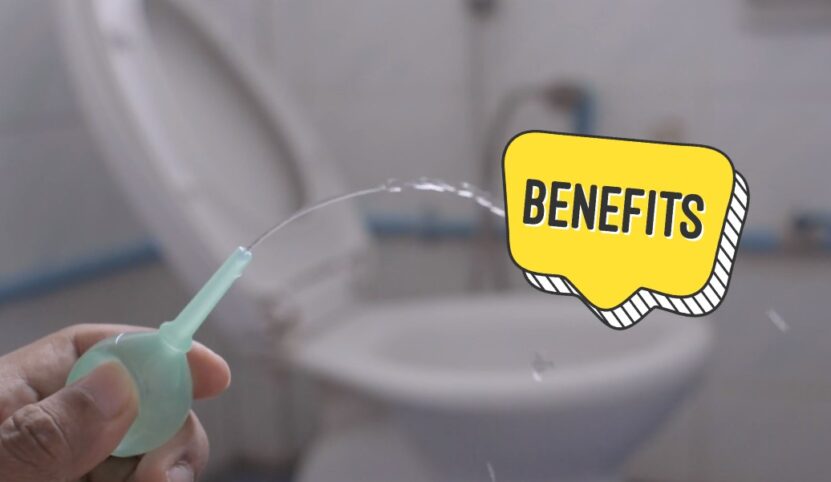Colon cleansing has long been a topic of interest and even controversy in medical and wellness circles. Among the methods utilized for this purpose are enemas, a procedure involving the introduction of fluid into the rectum and colon via the anus. Enemas are not only used for cleansing but also for therapeutic reasons in various health conditions. In this context, we will explore two types of enemas: mini enemas and regular enemas. While they may sound similar, they possess unique characteristics, applications, and benefits, which we’ll delve into throughout this article.
Mini Enema Explained

Mini enemas, as the name suggests, are a smaller, milder version of regular enemas. They typically involve the use of a smaller volume of fluid (usually between 5-15 milliliters), which is introduced into the lower part of the colon. The fluid is typically a hyperosmotic solution, meaning it draws water into the colon to stimulate a bowel movement. Mini enemas are a popular choice due to their convenience, portability, and less invasive nature.
Often, the administration of a mini enema requires less preparation time compared to a regular enema, making it a relatively quick procedure. The reduced fluid volume also means that the pressure and discomfort associated with larger enemas are significantly lessened. This makes mini enemas a more appealing choice for people who might be nervous about the procedure or who have specific medical conditions.
It’s important to note that while mini enemas can be a practical choice for certain circumstances, they are not a one-size-fits-all solution. Their smaller scope means they have a more localized effect, primarily addressing issues in the lower part of the colon. For conditions that require more extensive colon cleansing, a regular enema may be more effective.
Regular Enema Explained

Regular enemas, also known as large-volume enemas, involve the introduction of a larger volume of fluid (often between 500 milliliters to 1 liter) into the colon. This fluid may contain water, saline, or other medicinal solutions. Regular enemas act to cleanse the entire length of the colon, unlike mini enemas, which only target the lower part.
A regular enema is often administered using an enema bag and a tube with a nozzle at the end. The fluid is gradually introduced into the colon, stimulating a bowel movement. While the procedure can be slightly more uncomfortable due to the larger volume of fluid, regular enemas can provide more extensive colon cleansing. This makes them particularly useful in a wider range of medical conditions.
Though they might be a bit more time-consuming and invasive than mini enemas, regular enemas are beneficial for a thorough cleanse or for administering certain medications. The larger volume allows the solution to reach further into the colon, providing a broader scope of action. However, they should be administered under the guidance of a healthcare professional to avoid any potential complications.
Key Differences Between Them
The main differences between mini enemas and regular enemas stem from their size, procedure, and scope of action. The smaller volume of a mini enema makes the procedure quicker, less invasive, and generally more comfortable. However, the localized action limits its effectiveness to the lower part of the colon. On the other hand, regular enemas, with their larger fluid volume, provide more extensive colon cleansing, reaching further into the colon.
The nature of the solutions used also differs. Mini enemas typically use hyperosmotic solutions that work by drawing water into the colon, while regular enemas may use a variety of solutions, including water, saline, or medicated solutions. The type of solution used often depends on the condition being treated and the desired effect.
The method of administration also varies. Mini enemas are often self-administered using a pre-filled applicator, while regular enemas usually require an enema bag and tube and may need assistance for administration. The choice between a mini enema and a regular enema often depends on the individual’s health needs, comfort levels, and the specific medical advice they’ve received.
Purpose and Benefits of Mini Enemas

Mini enemas serve as a quick and convenient solution for inducing bowel movements, particularly in individuals who have difficulty with regular bowel movements due to various conditions such as constipation, hemorrhoids, or IBS (Irritable Bowel Syndrome). They also have the added benefit of being self-administered with relative ease, giving users a sense of control and privacy.
Furthermore, mini enemas have a valuable place in the management of chronic constipation, especially when oral laxatives are ineffective or not recommended. They act relatively quickly (usually within 5-20 minutes), and the induced bowel movements tend to be more comfortable than those produced by larger-volume enemas.
In a healthcare or hospital setting, mini enemas can be useful for preparing patients for certain diagnostic procedures, such as a sigmoidoscopy, where clear visibility of the lower colon is required. They are also often used in post-surgical care when patients have difficulty initiating a bowel movement due to anesthesia or pain medications.
Purpose and Benefits of Regular Enemas
Regular enemas have a more diverse range of uses due to their larger scope of action. They are often used for treating severe constipation and fecal impaction, where mini enemas may not be effective. They can also be used to administer the medication directly into the colon in conditions such as inflammatory bowel disease, helping to target the problem area directly.
Regular enemas can also play a role in preparing the bowel for certain medical procedures or surgeries that require a thoroughly cleansed colon. This might include procedures like colonoscopies or colorectal surgeries. In such cases, a regular enema can help to ensure that the doctor has a clear view of the colon or that the surgical field is clean.
Additionally, regular enemas can be used as part of detoxification or wellness protocols. Some people find that regular enemas help to enhance their overall sense of well-being, improving digestion and reducing bloating. However, it’s essential to note that the use of enemas for detox purposes is controversial, and their effectiveness and safety have been questioned. Always consult with a healthcare provider before undertaking any new health regimen.
Types of Conditions Treated with Mini Enemas

Mini enemas are commonly used to manage constipation, a condition that affects many people at various stages of life. They can be particularly useful for individuals with chronic constipation that does not respond well to dietary changes or oral laxatives.
In the realm of gastrointestinal disorders, mini enemas also find use in the management of IBS, particularly when constipation is a prominent symptom. In a hospital setting, mini enemas are often used to facilitate bowel movements in postoperative patients who might be dealing with medication-induced constipation.
Furthermore, mini enemas can be a helpful tool for people with certain neurological conditions, such as multiple sclerosis or spinal cord injuries, who may have difficulty with bowel control. The convenience, speed, and local effect of mini enemas can help manage bowel regularity in these cases.
Types of Conditions Treated with Regular Enemas
Regular enemas have a broader scope and can be used in a variety of conditions. For starters, they’re a vital tool in managing severe constipation or fecal impaction, where a larger volume of fluid is needed to effectively cleanse the colon.
Inflammatory bowel diseases such as ulcerative colitis or Crohn’s disease can also be managed with medicated regular enemas, delivering anti-inflammatory drugs directly to the affected areas of the colon. Regular enemas are also used as part of the preparation process for many gastrointestinal procedures, ensuring a clean and clear view for colonoscopies or surgeries.
Interestingly, regular enemas have found a place in the treatment of certain types of poisoning. Some toxic substances can be eliminated more rapidly from the body by cleansing the colon, making regular enemas a valuable tool in these emergencies.
Effectiveness and Efficiency of Both
When it comes to effectiveness, both mini and regular enemas have proven their worth in specific circumstances. Mini enemas are efficient at relieving constipation, facilitating bowel movements, and preparing the lower part of the colon for procedures. They work swiftly, with effects usually seen within 5-20 minutes of administration.
Regular enemas, while more invasive and time-consuming, are effective at cleansing the entire colon. They are efficient in the management of severe constipation or fecal impaction, administering medication for certain bowel diseases, and preparing the entire colon for procedures. The time to effect can vary greatly, depending on the purpose of the enema and the individual’s physiology.
Both mini and regular enemas have an essential place in healthcare, with their choice and use largely determined by the condition being treated and the specific needs of the individual. As with any medical procedure, their effectiveness and efficiency can be greatly improved by adhering to correct administration techniques and guidelines.
Side Effects and Precautions
While enemas can be a beneficial tool, they also come with potential side effects and precautions. Both mini and regular enemas can lead to dehydration if used excessively, due to the loss of fluid and electrolytes from the body. Other side effects may include cramping, bloating, nausea, or diarrhea. In rare cases, repeated or improperly administered enemas can cause damage to the rectal wall.
People with certain conditions such as heart disease, kidney disease, or electrolyte imbalances should use enemas with caution due to the risk of fluid and electrolyte disturbances. Always consult a healthcare provider before starting a regimen of enemas, especially if you have any chronic health conditions or are currently taking any medications.
Enemas should not be used as a long-term solution for constipation. If constipation is a persistent issue, it’s important to seek medical advice, as it can be a symptom of other underlying conditions. Lastly, while enemas can be a part of a general wellness routine, they should not replace a healthy diet and regular exercise, which are vital for maintaining good digestive health.
Choosing the Right Enema: Factors to Consider

Choosing the right enema largely depends on the specific needs of the individual and the advice of a healthcare provider. Factors such as the condition being treated, the desired effect, comfort levels, and medical history all play a role in this decision.
If a quick and less invasive solution is needed for a mild constipation problem or to prepare for a lower colon procedure, a mini enema might be the best choice. For more severe constipation, fecal impaction, or when a more extensive colon cleanse is needed, a regular enema might be more effective.
It’s also crucial to consider the frequency of use, as overuse of enemas can lead to dependency and disrupt the natural function of the colon. Remember that while enemas can be a valuable tool, they are not a cure-all solution and should be used as part of a comprehensive approach to health and wellness.
Final Words
Both mini and regular enemas have their unique purposes, benefits, and applications in healthcare. They each serve as invaluable tools for managing a range of conditions and improving the quality of life for many individuals. The key is to understand their differences, know when to use each one, and always seek professional advice before starting any new health regimen.
In navigating the world of enemas, knowledge is truly power. By understanding the ins and outs of mini and regular enemas, you can make more informed decisions about your health.

